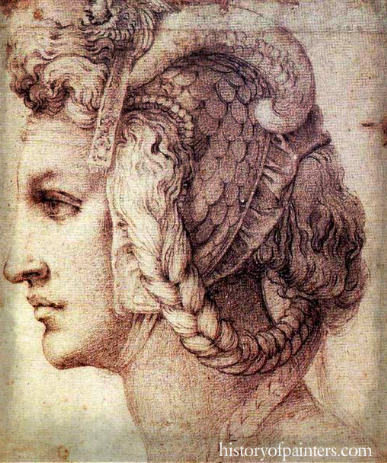Michelangelo
di Lodovico Buonarroti Simoni
1475-1564
One of the Greatest Painters Of All Time
Italian Florentine, Renaissance Painter, Sculptor, Architect and Poet
Stylistically influenced by the following painters - Masaccio, Sandro Botticelli, Paolo Veneziano, Sano di Pietro and Classical Greek
Cause of Death: Fever

Distinguished author and historian, John C. Van Dyke
points
out"Michelangelo has been called the "Prophet of the Renaissance," and
perhaps deserves the title, since he was more of the Old Testament than
the New—more of the austere and imperious than the loving or the
forgiving. There was no sentimental feature about his art. His
conception was intellectual, highly imaginative, mysterious, at times
disordered and turbulent in its strength. He came the nearest to the
sublime of any painter in history through the sole attribute of power.
He had no tenderness nor any winning charm. He did not win, but rather
commanded. Everything he saw or felt was studied for the strength that
was in it. Religion, Old-Testament history, the antique, humanity, all
turned in his hands into symbolic forms of power, put forth apparently
in the white heat of passion, and at times in defiance of every rule
and tradition of art. Personal feeling was very apparent in his work,
and in this he was as far removed as possible from the Greeks, and
nearer to what one would call to-day a romanticist. There was little of
the objective about him. He was not an imitator of facts but a creator
of forms and ideas. His art was a reflection of himself—a
self-sufficient man, positive, creative, standing alone, a law unto
himself."
In the story of Michelangelo's life the strength, often turning to bitterness, is not far to seek; a discordant note sounds throughout it which almost spoils the music. He "treats the Pope as the King of France himself would not dare to treat him"; he goes along the streets of Rome "like an executioner," Raffaelle says of him. Once he seems to have shut himself up with the intention of starving himself to death. As we come in reading his life on its harsh, untempered incidents, the thought again and again arises that he is one of those who incur the judgment of Dante, as having "willfully lived in sadness." Even his tenderness and pity are embittered by their strength. We know little of his youth, but all tends to make one believe in the vehemence of its passions. But his genius is in harmony with itself; and just as in the products of his art we find resources of sweetness within their exceeding strength. Michelangelo's art makes us spectators of this struggle; the struggle of a strong nature to adorn and attune itself; the struggle of a desolating passion, which yearns to be resigned and sweet and pensive.
Scandal in the Vatican
In the year 1545 Pietro Aretino, the Venetian author, wrote a strange letter to Michelangelo. As a Christian he disapproved of the freedom which the master had taken in his treatment of the Last Judgment. It was a scandal that such a work should be daily seen in the greatest temple of Christianity, upon the chief alter of Jesus, and the holiest chapel in the world, by the Pope himself. Pietro felt that Michelangelo committed blasphemy in representing the Heavenly Father as Jupiter and the saints as ancient heroes. He pressed the Church to imprison Michelangelo for taking such liberties with holy matters. The Pope refused.
Require more information and facts about Michelangelo's biography and other great Renaissance painters ? Poke around every nook and cranny of the known universe for information this subject. Search Here
Do you know something we don't? If you have comment or would like to share an insight regarding Art History, please submit your comment to the editor, via e-mail and if possible site the source. Thank you!
© HistoryofPainters.com If you like this page and wish to share it, you
are welcome to link to it, with our thanks.
| links | book store | top 50 painters | art supplies | illuminated manuscripts |
| site map | medieval | artist quotations | iconography | 100 greatest paintings |